Number Nine was a graphics card manufacturer for the IBM PC and its compatibles based out of Lexington MA, USA. Started in 1982 by Andrew Najda and Stan Bialek as Number Nine Computer Corporation, the company was renamed in the early nineties to Number Nine Visual Technology Corporation.
Their first hardware was a MOS 65c02 microprocessor-based accelerator board for the Apple II. The company went on to develop another using the NEC µPD7220.
In 1993, seeing there was still a strong market for more consumer-oriented graphics cards, they built a close relationship with S3, releasing SVGA cards that used a variety of S3 chipsets. The GXE range used the early S3 chips including 928, Vision864, Vision964 and the first Trio64 chip, 764. This relationship would continue with the release of Number Nine cards leveraging the ViRGE and Savage line of chipsets.
In 1994, Number Nine moved away from their relationship with TI for their high-end offerings, choosing instead to develop their own custom chips. This introduced the Imagine 128 family of cards, all of which sat on the PCI bus and were the first 128-bit graphics processors on the market.
In 1995 the company went public with half of its 9 million shares closely held. At that time they had OEM agreements with Dell, Gateway 2000, IBM, Intel and Microsoft.
In the mid to late 1990s, Number Nine lost market share due to price and performance competition from other video card makers, particularly Matrox, 3dfx, Diamond, and ATI. Number Nine had been slow to respond to the boom in 3D graphics, and had continued to emphasize high quality, fast 2D graphics.
In late 1999 the company filed for Chapter 11 bankruptcy protection from creditors and agreed to sell most of its assets to S3 for $4.8 million. In the agreement, most of Number Nine's employees would continue to work for S3, and the deal was concluded in June 2000.
 GXi / #9GXi / GXi Lite GXi / #9GXi / GXi Lite
  
Launched: October 1991 (GXi),
Chipset: Texas Instruments TMS-34020 TIGA
Bus: ISA 16-bit
Memory: 1 MB DRAM + 1 MB VRAM (upgradable to 2 MB)
RAMDAC: ?
RAMDAC Speed: ?
VESA Standard: ?
FCC ID: -
Price When New: $2,495 (launch price), $1,024 - $1,995
The Number Nine GXi was launched in late 1991, and was the second card in the GX family, the first being the GX that retained the original TIGA chip, TMS-34010.
It was able to support screen resolutions of up to 1280 x 1024 with its TIGA (Texas Instruments Graphic Architecture) graphics coprocessor which could process up to 10 million instructions per second. Designed for high-resolution Windows 3.0 and 3.1 and CAD work, the GXi also came with hardware zoom and pan & scroll capabilities.
The card was able to handle 24-bit TrueColor colour depths which meant 16.7 million colours.
Overall, six GXi configurations were available to buy based on a variety of price points. The two entry-level options were not upgradable but supported resolutions up to 1024 x 768 with pricing from $1,024 to $1,295. The other four levels of card were upgradable and cost from $1,280 to $1,995. An optional floating-point math unit could be added to these, which added 128 KB of SRAM to aid CAD users with manipulating 3D objects.
GXi came with a solid suite of tools including the Hawkeye configuration application, Resolution Exchange, and Chameleon Cursor.
Number Nine also released a GXi Lite in 1991. This came is two flavours: Level 20 ($995) and Level 21 ($1,295). Level 21 added Windows' virtual screen capability with pan and zoom (something the GXi could do also), an AutoCAD display driver, and 1 MB of DRAM memory on top of the already-present 1 MB of VRAM. There was also an upgrade option for GXi Lite Level 20 owners to make it a full-blown Level 21 for $520. Like the main GXi, the Lite cards also ran a TMS34020.
All cards with a TMS34020 required a 41 KB TIGA TSR to be loaded for the Texas Instruments chip to be used.
More Images
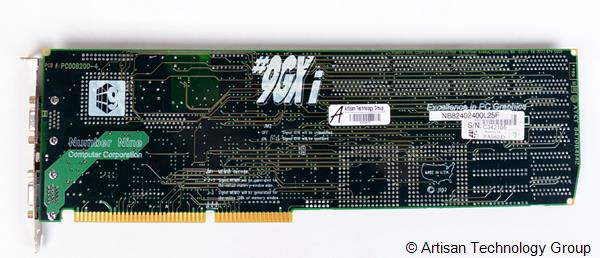 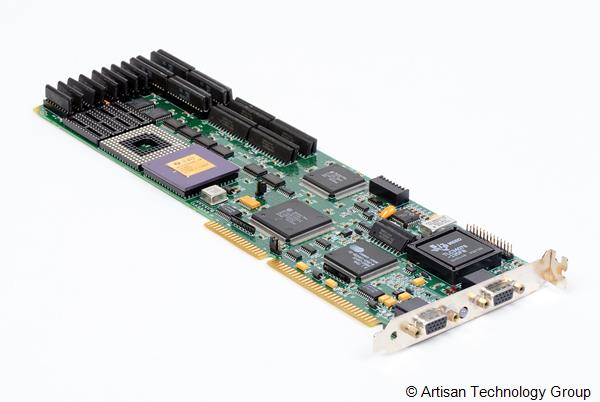
|
 GXiTC GXiTC
  
Launched: 1992
Chipset: Acumos AVGA2
Bus: ISA 16-bit
Memory: 512 KB DRAM (70ns) or 4 MB VRAM
RAMDAC: unknown
RAMDAC Speed: 135 MHz
VESA Standard: Yes, v1.1
FCC ID: -
BIOS Dates: 04/07/92
Known BIOS Versions: 340-007-11-Rev1.00
Price: $2,295 (1992)
This card, also known as the Acumos AVGA2, supports 1024x768 TrueColor or 1280x1024 at 64 K 60 Hz in Windows 3.11.
"In the WinTach tests, the #9GXiTC posted median-to-swift speeds. Although it's just slightly slower than the Volante, this card moves right along. In the CAD results, it even outpaced the Volante. Everything about this board is thoroughly impressive. Its easy installation and excellent documentation are great. Its screen clarity, sharpness, vivid colors, and Virtual Screen utilities are superb. Because of these utilities, crystal-clear display, and extensive DOS application drivers, I rate the #9GXiTC adapter highly." Byte's Essential Guide to Windows, 1992 |
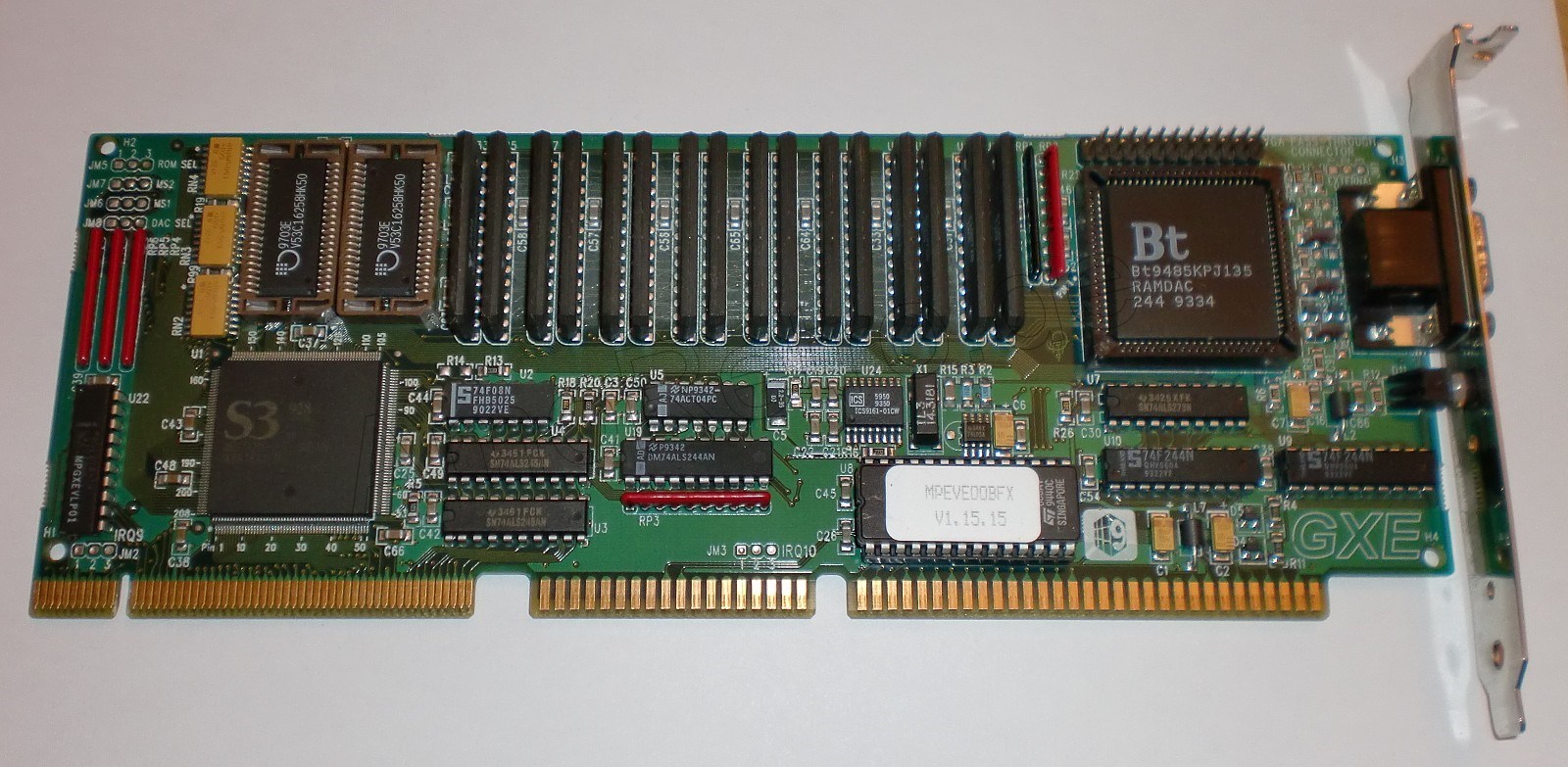 GXe / #9GXe GXe / #9GXe
   
Launched: 1993
Bus: 16-bit ISA or VESA Local Bus
Chipset: S3 Vision928
Pixel Clock: 135 MHz
Memory: 1 MB - 4 MB VRAM
RAMDAC: Brooktree Bt9485KP
Part #: PC0092xx02
FCC ID: JF9-GXE4MEG (#9GXE ISA version), JF9-GXEVLT (#9GXE VL version)
Price: $495 (1 MB, Dec 1992), $895 (4 MB, Dec 1992)
 Number Nine unveiled the #9GXe in late 1992 with shipping in early 1993. Based on the 'then-new' Vision928 chipset from S3, it supported screen resolutions as high as 1,280 x 1,024 (non-interlaced) in 256 colours, 1,152 x 870 in 65,536 colours, and 800 x 600 in 16.7 million colours. All these resolutions could be driven at 76 or 77 Hz refresh rate for flicker-free operation in 256-colour mode. Number Nine unveiled the #9GXe in late 1992 with shipping in early 1993. Based on the 'then-new' Vision928 chipset from S3, it supported screen resolutions as high as 1,280 x 1,024 (non-interlaced) in 256 colours, 1,152 x 870 in 65,536 colours, and 800 x 600 in 16.7 million colours. All these resolutions could be driven at 76 or 77 Hz refresh rate for flicker-free operation in 256-colour mode.
The GXe straddled the brief time when VESA Local Bus and ISA cards were competing in the high-end video card market. The only difference between the ISA-based #9GXe and the VESA Local Bus one was that latter came with a dual-pin VGA pass-through connector. Typical of early 1993, both cards had the same list price of $495 at launch.
The card came in three memory sizes: 1 MB, 2 MB and 4 MB, all of which used the faster VRAM (video RAM) that ran at 60ns, instead of the cheaper and slower DRAM. In its launch year it competed against such cards as the ELSA Winner 1000 ($599), ATI Graphics Ultra Pro ($499), Hercules Graphite Pro ($549), Matrox MGA Ultima ($899), Diamond Viper VLB ($499), and Orchid Fahrenheit VA/VLB ($349).
Against the competition the #9GXe was the fastest VESA Local Bus card you could buy apart from the Actix GraphicsEngine Ultra VL ($399) though the ISA-based version was the fastest when compared to other high-end ISA cards. It also boasted the best utility software with its "HawkEye" Control Panel and other tools. Other cards it competed with include the ATI Graphics Ultra Pro, Hercules Graphite, Diamond Stealth Pro, and Orchid Fahrenheit VA.
More Images
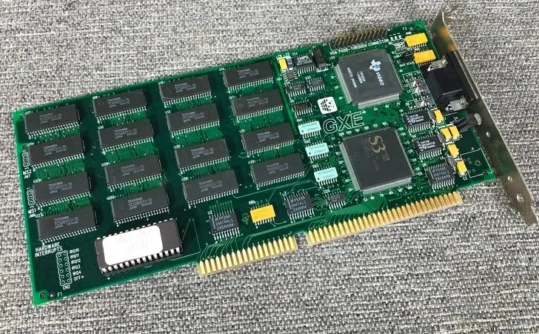 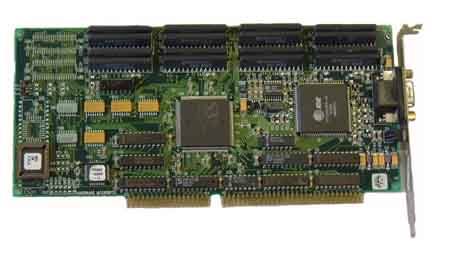
|
.jpg) GXE64 / #9GXE64 GXE64 / #9GXE64
   
Launched: 1994
Bus: VESA Local Bus or PCI
Chipset: S3 Vision864 (86C864)
Memory: 1 MB or 2 MB DRAM
RAMDAC: AT&T ATT41C298
Part #: PC00APSO-2
FCC ID: JF9-GXE64PCI
Price: $175 (1 MB VLB or PCI), $249 (2 MB VLB or PCI) - July '94
Known BIOS Versions: 1.02.04
The #9GXE64 arrived a year after the first #9GXe cards, this time with Number Nine dropping the ISA bus and adopting PCI as the new bus option.
It used the new graphics accelerator chip from S3, Vision864, which compared to the GXe's Vision928 had a wider 64-bit memory data path and came with motion video acceleration features including color space conversion and video scaling, though it used the slower Fast Page Mode DRAM memory (the 86C9xx series support VRAM while the 86C8xx series only support DRAM.
The card was also Number Nine's first to sport the Advanced Video Connector (AVC) socket, though this was rarely used.
Other cards that used the Vision864 include the SPEA V7-Mirage P-64, Diamond Stealth 64, Orchid Fahrenheit 64, and Genoa Phantom 64.
More Images
.jpg)
|
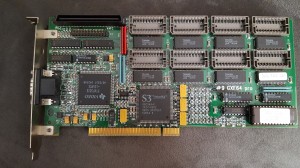 GXE64 Pro GXE64 Pro
   
Launched: 1994
Chipset: S3 Vision964
Bus: PCI or VESA Local Bus
Memory: 2 MB or 4 MB
VRAM (64-bit)
RAMDAC: Texas Instruments PTVP3025
RAMDAC Speed: 200 MHz
FCC ID: JF9-GXE64PROPCI
Price: $799 (4 MB, 1994), $499 (2 MB, 1994)
The GXE64 Pro came in both PCI and VESA Local Bus form, with them both retailing for $499 for the 2 MB version. Aside from the big S3 chip, the Texas Instruments chip is a 64-bit video interface palette, providing True-Color (16-bit) and Direct-Color (24-bit) modes. The GXE64 Pro supports resolutions up to 1600 x 1280 with 65,536 colours, and up to 16.7 million colours at lower resolutions.
This card comes as standard with 2 MB of Toshiba multiport 70ns video RAM in 40-pin SOJ (Small Outline J-Lead) form, but is expandable to 4 MB with the addition of eight more 40-pin SOJ DRAM chips - these are like DIPs but their pins form a 'J' underneath. Memory bandwidth is 240 MB/sec.
"Users will soon be able to buy graphics accelerator boards based on S3 Inc.'s high-end 64-bit chip, as Number Nine Computer Corp., and Diamond Computer Systems Inc. gear up to ship products later this month.
The Vision 964 graphics accelerator
chip offers users fast performance with high color resolutions, according to S3.
Both companies will ship their boards with a variety of memory configurations in versions for either Peripheral Component Interconnect (PCI) or Video Electronics Standards Association (VESA) local buses.
With 2MB of video RAM (VRAM), the Number Nine #9GXE64 Pro costs $499 and displays resolutions as high as 1,280 by 1,024 with 256 colors.
With 4MB of VRAM, the board costs $749 and supports resolutions of 1,600 by 1,200 with 256 colors. A version with a 200 MHz digital-to-analog converter (DAC) lists for $999.
The boards come with Number Nine's HawkEye Display Utilities, which can adjust refresh rates and switch resolutions and color depths in Windows.
The utilities offer an unusual number of features, including the ability to program the cursor's color. Other features include gamma and color correction and a color border.
Diamond is shipping its Stealth 64
board for $399 with 2MB of VRAM. It displays resolutions as high as 1,280 by 1,024 with 256 colors and a refresh rate of 75 hertz. A 4MB version is also available. Diamond also includes software utilities for changing parameters such as color depth and cursor color.
Both companies' boards are Energy Star-compliant and come with the VESA
Advanced Feature Connector for hooking up to motion video cards.
Miro Computer Products, Inc., in Palo Alto, Calif., also plans to announce and ship a card based on S3's 64-bit chip this month or next, a spokesman said."
Infoworld, 4th April 1994
In one buyer guide at the time, they said "The GXE64 Pro provides above-average speeds for DOS programs and good overall Windows performance. Although not the fastest card, it provides easy-to-use utilities and high refresh rates that provide relief for your eyes."
In the top-left of the PCI version of the card you can see the VAFC, or VESA Advanced Feature Connector, which is 32-bit, and just below it the old 8-bit SVGA feature connector for faster transfer of motion video and additional data from other cards. The VLB variant only got the older feature connector.
More Images

|
Imagine 128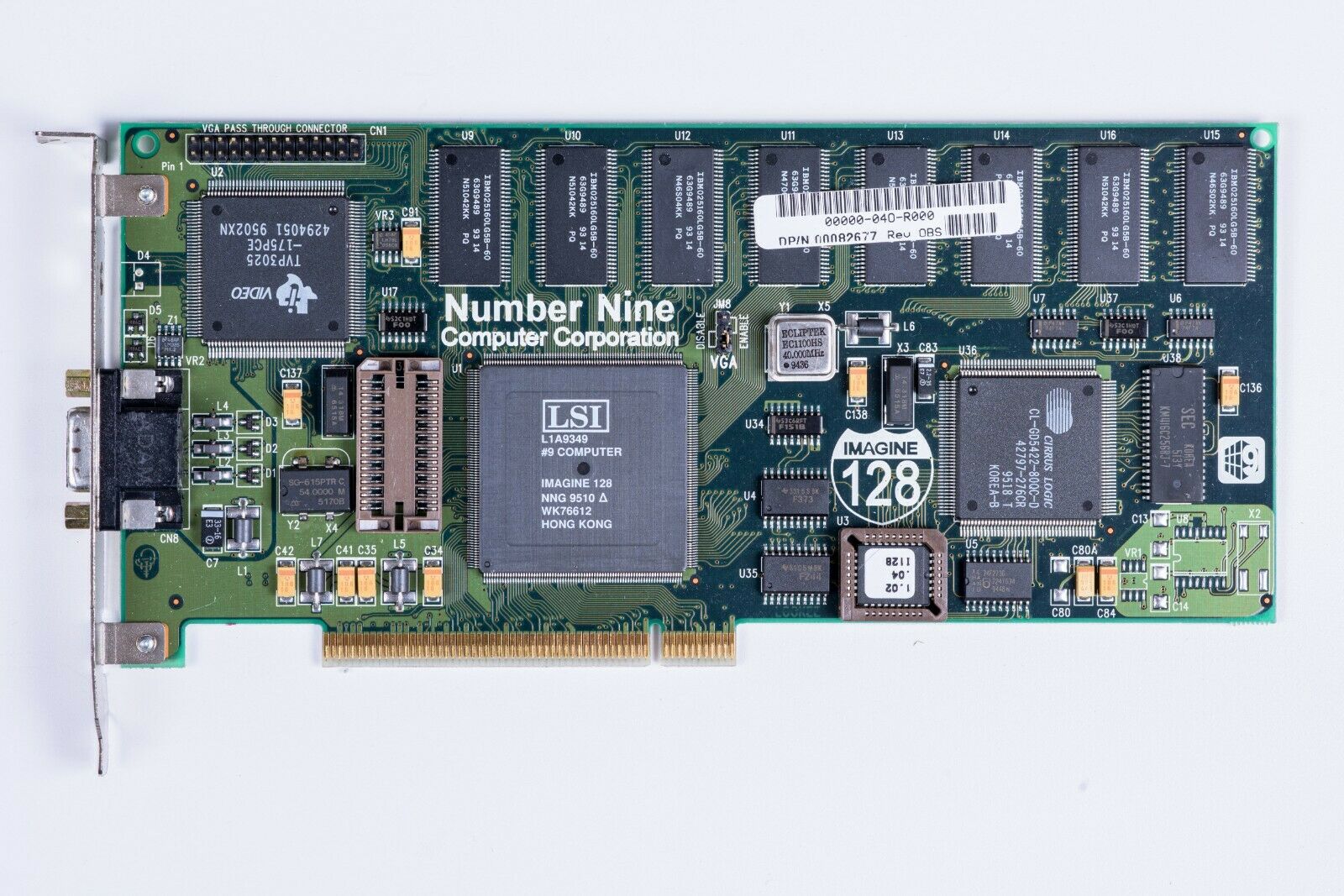
   
Launched: 1994
Bus: PCI
Chipset: Imagine 128, Cirrus Logic CL-GD5422
RAMDAC: Texas Instruments PTVP3025
Memory: 4 MB
Price: ?
Launched at the all-important Comdex trade show in 1994, the Imagine 128 was the first 128-bit graphics card to hit the market when all its competitors were just unveiling their 64-bit graphics cards. With its first ever chip built in-house, it had a 128-bit graphics engine and 128-bit memory architecture to achieve the highest data throughput of any graphics card on the market. Despite this high throughput, their GPU had little to no hardware support for 3D graphics operations.
"Both the Imagine 128 ($699 list) and its newer sibling, Imagine 128 Series 2 ($699 list) combine top-flight performance with exceptional utilities and productivity tools. An Editor's Choice in last year's high-end review, the Imagine 128 has aged well, and remains an excellent choice for handling large bitmaps and vector graphics. The Series 2 boasts a souped-up 2-D graphics engine, and as-yet untapped features that promise to deliver enhanced video and 3-D capabilities as well.
Both cards feature Number Nine's Hawkeye95 display control utilities, a user-oriented suite that is among the best designed in the business. Accessible via the Display Properties dialogue or directly from the Windows 95 taskbar, Hawkeye95's individual components work together to form an integrated set of tools.
Valuable features include an excellent status page that lists everything from the current resolution and driver version to the bus size and BIOS revision. A simple but effective Monitor Adjustment utility lets you safely adjust the refresh rate and create custom configurations, and a well-designed color
calibration utility called Color Perfect includes individual linear adjustments in RGB or CMY color space.
The Imagine 128 and Imagine 128 Series 2 run neck and neck at the top end of the 2-D accelerator market. Each delivers super-fast refresh rates, topping out at an astounding 83 Hz in 1,600-by-1,200 16-bit color mode - if you can afford a monitor to handle that combination.
While we were unable to test the Series 2's performance in several areas - the card's MPEG and CAD software arrived after we had completed testing, and its OpenGL drivers for Windows NT remain unavailable as of this writing - a look at the card's WinBench 96 scores provides some insight into the chip's raw capability. At a resolution of 1,024-by-768 in true color mode, the card achieved an excellent Graphics Winmark score
of 26.5. To put this into perspective, consider that most current midrange products process roughly the same number of pixels in 256-color mode as the Series 2 processes in true-color mode.
Under Windows 95, the early Series 2 drivers we tested did not completely deliver on the new chip's promise, but were solid and complete and include advanced DirectDraw support. The card is expected to scale nicely as Pentium Pro processors and 64-bit PCI buses enter the market, thanks in part to its Intelligent Command Processor and support for PCI bursts.
The older Imagine 128, no performance slouch itself, was the fastest Photoshop and QuarkXPress engine, finishing just ahead of the Series 2.
If you want rock-solid images and the best tools in the business consider either Imagine card. As Number Nine improves he breadth and depth of the Series 2
drivers, this promises to be the card to watch - JH"
PC Magazine, 25th June 1996
More Images
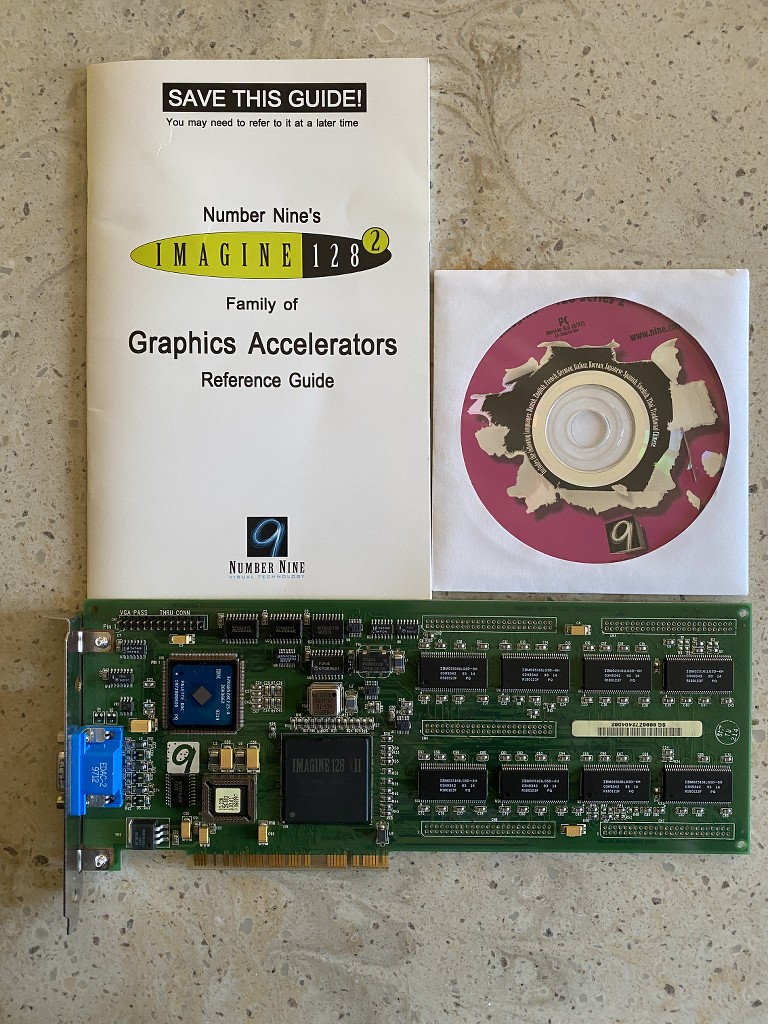
|
 GXE64 Pro 1600 PCI GXE64 Pro 1600 PCI
   
Launched: 1995
Chipset: S3 Vision964 (86C964)
RAMDAC: Texas Instruments PTVP3025
RAMDAC Speed: 220 MHz
Bus: PCI
Memory: 4 MB VRAM
Price:
Based on the same core graphics engine as the earlier GXE64 Pro, the S3 Vision964.
"The #9GXE64 Pro 1600 PCI is the odd one out among the four Number Nine cards we reviewed. Based on the older S3 Vision964 accelerator chip, the #9GXE64 Pro performs on a par with Number Nine's newer #9FX Motion771 graphics accelerator, yet it lacks that card's multimedia functions and costs $200 more. Given its somewhat pedestrian performance numbers and its inability to produce true color at resolutions higher than 1,152 by 864 pixels, the #9GXE64 Pro represents a questionable choice for Windows use.
The #9GXE64 Pro's shining moment is in its AutoCAD performance, however. On the 3-D Pan test, the card shot into first place; it took third place on our Redraw All test. But given the availability of more full-featured, less costly cards that incorporate later-generation accelerators, the #9GXE64 Pro would only make sense for someone who spends time in AutoCAD for DOS and doesn't need more than midrange Windows graphics performance.
Though the aging 64-bit S3 Vision 964 graphics accelerator is certainly nothing to sneeze at, this chip has been surpassed by later models from S3 and utterly outclassed by the latest chips from ATI Technologies and Matrox Graphics, and Number Nine. The S3 Vision 964 has all
of the GUI features built into its core, including the ability to perform BitBlts, line draws, and pattern fills. What's missing is the video acceleration built into the Vision 968.
The 220-MHz Texas Instruments RAMDAC and 4MB of VRAM
combine nicely with the S3 Vision 964 to deliver above-average refresh rates of 120 Hz at 1,024 by 768 at 24-bit color and 76 Hz at both 1,280-by-1,024 and 1,600-by-1,200 resolutions with 16-bit color.
The muscle behind the #9GXE64 Pro's impressive AutoCAD performance could well lie in its Number Nine-engineered PowerPac drivers. Where virtually every other card we saw came with a version of Panacea's TurboDLD drivers, the PowerPac suite leverages Number Nine's long experience with CAD. That the drivers make most of the difference in CAD performance is borne out by the card's poor performance on our Vector File Open tests: Here, the #9XE64 Pro limped to a tie for last place.
Windows graphics performance was a strangely mixed bag. Though the #9GXE64 Pro garnered squarely average marks for true-color 1,024-by-768 performance on the Winstone 95 and Graphics WinMark 95 tests, it shot up to third place on the Raster Rotate test at the same resolution and color depth. Interestingly, the #9GXE64 Pro outpaced Number Nine's Motion771 on our applications-based Winstone tests but was in turn bested by the Motion771 on the Graphics WinMark tests. These results would seem to indicate that the #9GXE64 Pro fares slightly better on real-world Windows tasks than the Motion771."
PC Magazine, 27th June 1995
|
.png) GXE64 Trio GXE64 Trio
  
Launched: 1995
Bus: VESA Local Bus or PCI
Chipset: S3 Trio64
Memory: 1 MB or 2 MB DRAM
DAC: (embedded in S3 chip)
Price: ?
Part #: PC00EPSO-2
FCC ID: JF9-GXE64TRIOPCI
More Images
.png) .png) 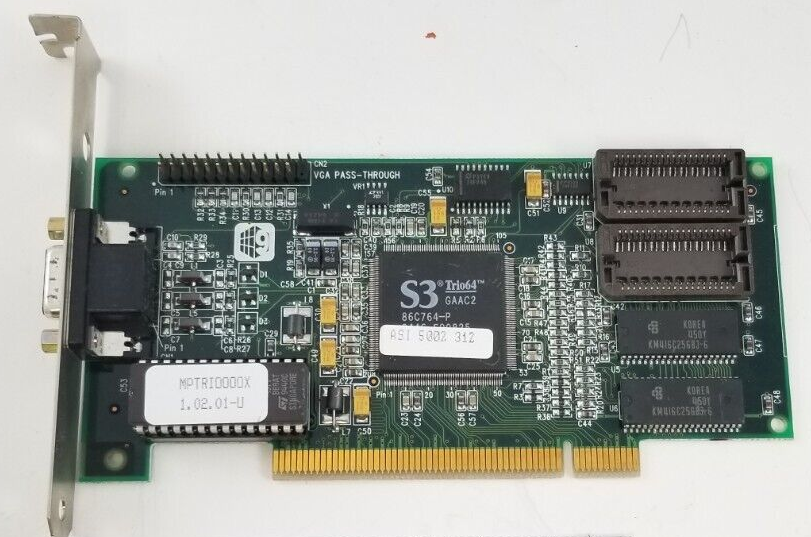 .png)
|
 9FX Vision 330 9FX Vision 330
   
Launched: 1995
Bus: VESA Local Bus or PCI
Chipset: S3 Trio64
DAC: ?
Price: ?
The Vision 330 was part of Number Nine's "9FX" series in 1995, which also comprised Motion 531 and Motion 771 cards. The Vision 330 was the budget offering of the trio, as noted by the advert which called it "The affordable 64-bit graphics accelerator to improve PC performance".
It came with 2 MB of DRAM memory.
Advert |
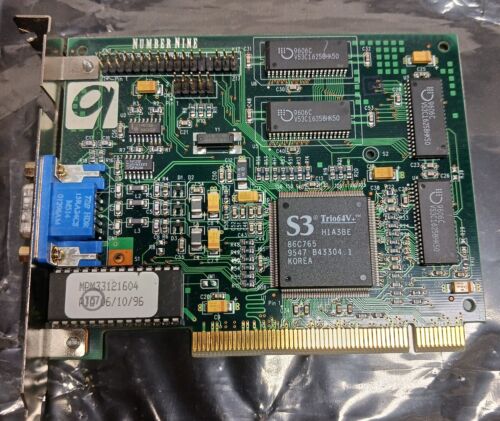 9FX Motion 331 9FX Motion 331
   
Launched: 1996
Bus: PCI or VESA Local Bus
Chipset: S3 Trio64V+ (86C325)
Memory: 1 MB DRAM (expandable to 2 MB), or 2 MB DRAM
DAC: (embedded in S3 chip)
FCC ID: JF9-S3765PCI
Part #: 00-331-005-001, 00-331-006-001, 00-331-006-002, PC00JPSO-04
Price: ?
Known BIOS Versions:
2.16.04MO, 2.16.08, 2.18.08, 2.36.07
The picture on the right shows the 2 MB DRAM version that was factory-fitted. The pics below shows the 1 MB DRAM version with sockets for expansion to 2 MB.
More Images
.jpg) .jpg) .jpg)
.jpg) .jpg)
.png) .png) .png)
|
 9FX Motion 531 9FX Motion 531
   
Launched: 1995
Bus: PCI or VESA Local Bus
Chipset: S3 Vision868 (86C868)
Memory: 1 MB (upgradable to 2 MB) DRAM
DAC: ?
Price: ?
The Motion 531 was part of Number Nine's "9FX" series in 1995, which also comprised Vision 330 and Motion 771 cards. The Motion 531 was the mid-range offering of the trio, as noted by the advert which called it "The 64-bit accelerator for enhanced graphics & video".
It came with 2 MB of DRAM memory.
Advert |
.jpg) Motion 771 Motion 771
   
Launched: 1995
Bus: PCI or VESA Local Bus
Chipset: S3 Vision968
RAMDAC: IBM RGB524
RAMDAC Speed: 220 MHz
Memory: 4 MB VRAM
Price: $499 (street price)
Known BIOS Versions: 2.05.09
The Motion 771 was part of Number Nine's "9FX" series in 1995, which also comprised Vision 330 and Motion 531 cards. The Motion 771 was the flagship offering of the trio, as noted by the advert which called it "The ultimate 64-bit VRAM accelerator for power graphics & video".
Based on S3's Vision968 chipset, it could output resolutions up to 1600 x 1200 in 64K colours at 75 Hz refresh rate.
Numerous other cards that year were also based on this same S3 chipset, including the Diamond Stealth 64 Video VRAM, ELSA Winner 2000 Pro/X, Genoa VideoBlitz III AV, Hercules Graphite Terminator Pro, and STB Velocity 64V. All these also came with 4 MB of VRAM and many implemented the same IBM 220 MHz RAMDAC, though the Diamond and ELSA cards instead chose the equivalent TI PTVP3026 RAMDAC, which also ran at 220 MHz.
"The #9FX Motion771 falls squarely into the middle of the current crop of high-end graphics cards. Incapable of true-color resolutions higher than 1,152-by-864, this card isn't aiming at the high end. But driven by the latest S3 Vision968 64-bit graphics accelerator, it offers respectable true-color performance at 1,024-by-768 for those whose needs aren't driven by super-high resolution and whose budgets demand cost-conscious solutions.
Like Number Nine's Imagine128 offerings (also reviewed here), the Motion771 comes with the outstanding HawkEye
for Windows utilities set. If you're looking for a true-color-capable card with decent performance at true-color resolutions and above-average 16-bit Windows and 8-bit AutoCAD speeds, the Motion771 is an excellent choice.
Four megabytes of VRAM, a 220-MHz IBM RGB524 RAMDAC, and the S3 Vision968 graphics controller add up to a strong hardware pedigree. The S3 Vision968 controller delivers a solid set of features and performance enhancements, including the usual BitBlt, line-draw, and pattern-fill functions. New to the S3 Vision968 is hardware video acceleration, and that is what puts the motion into the name of this card. The S3 Vision 968 hardware offers x-axis video scaling; the y-axis is implemented in the Motion771's DCI driver set. Though we didn't formally test video playback, we noticed that when we stretched Video for Windows clips on our test-bed, the resulting interpolated image was far finer and less pixelated than images on cards without video acceleration.
On our Graphics WinMark 95 tests, the Motion771 fell close to the bottom in 1,024-by-768
true color. A switch to 16-bit color at a resolution of 1,600-by-1,200 pixels brought the Motion771 to the top third of the line up. Interestingly, on our Raster Rotate test, the Motion771 turned in an excellent performance - coming in fourth overall. On the AutoCAD 3-D Pan test, the card pulled into an impressive third place,, while on both the Windows-based Vector File Open and the AutoCAD Redraw All tests, the Motion771 dropped back into the mid-range."
PC Magazine, 27th June 1995
Advert
More Images
.jpg) .jpg) .jpg) .jpg)
|
.jpg) Imagine 128 Series 2 / Imagine 128-II Imagine 128 Series 2 / Imagine 128-II
   
Launched: 1996 (4 MB), November 1996 (8 MB)
Bus: PCI
Chipset: Imagine128 Series II + Cirrus Logic CL-GD5424
RAMDAC: IBM 26H3662
Memory: 4 MB EDO DRAM (Series 2e), 4 or 8 MB EDO VRAM, or 8 MB H-VRAM (Series 2)
Part #: PC00FPLO-2
FCC ID: JF9-I2PC4MW
Price: $699 (S2 4 MB at launch), $399 (S2e 4 MB at launch), $699 (S2 8 MB at launch), $499 (S2 4 MB Nov '96), $349 (S2e 4 MB Nov '96)
Known Board Revisions: A01
Known BIOS Versions: 3.01.03
Launched in 1995, the Imagine 128 Series 2 was essentially two graphics cards in one. For basic 2D graphics it came with a Cirrus Logic CL-GD5424 graphics processor on the rear of the card with 512 KB of onboard memory (the top-right memory chip). There is also an SOJ socket in the lower-right to expand this portion of the card to 1 MB. For fast Windows GUI acceleration and 3D graphics, the card had the Imagine128 II processor chip. This chip doesn't get used at all until the Windows driver loads, so all of the DOS-based display is handled by the CL chip.
The
primary upgrade over the earlier Imagine 128 from the year before was the introduction of an Intelligent Command Processor that was a VLIW processor which enabled the CPU to send multiple drawing commands directly into the graphics memory in a FIFO (First In, First Out) execution manner. The CPU was offloaded by a hardware DIB conversion (Microsoft Windows Device Independent Bitmap). The graphics accelerators chip’s 100 MHz memory controller could handle 800 megabytes per second single ported performance with EDO-DRAM, and with VRAM even more. It came with a Direct3D driver and the company claimed it could do 610,000 Gouraud-shaded 50-pixel triangles per second in 16-bit color.
The address the limitations of the Imagine 128, Number Nine added Gouraud shading, along with 16-bit and 32-bit Z-buffering, volume clipping, spatial blending, double display buffering, and a 256-bit video rendering engine.
"Both the Imagine 128 ($699 list) and its newer sibling, Imagine 128 Series 2 ($699 list) combine top-flight performance with exceptional utilities and productivity tools. An Editor's Choice in last year's high-end review, the Imagine 128 has aged well, and remains an excellent choice for handling large bitmaps and vector graphics. The Series 2 boasts a souped-up 2-D graphics engine, and as-yet untapped features that promise to deliver enhanced video and 3-D capabilities as well.
Both cards feature Number Nine's Hawkeye95 display control utilities, a user-oriented suite that is among the best designed in the business. Accessible via the Display Properties dialogue or directly from the Windows 95 taskbar, Hawkeye95's individual components work together to form an integrated set of tools.
Valuable features include an excellent status page that lists everything from the current resolution and driver version to the bus size and BIOS revision. A simple but effective Monitor Adjustment utility lets you safely adjust the refresh rate and create custom configurations, and a well-designed color
calibration utility called Color Perfect includes individual linear adjustments in RGB or CMY color space.
The Imagine 128 and Imagine 128 Series 2 run neck and neck at the top end of the 2-D accelerator market. Each delivers super-fast refresh rates, topping out at an astounding 83 Hz in 1,600-by-1,200 16-bit color mode - if you can afford a monitor to handle that combination.
While we were unable to test the Series 2's performance in several areas - the card's MPEG and CAD software arrived after we had completed testing, and its OpenGL drivers for Windows NT remain unavailable as of this writing - a look at the card's WinBench 96 scores provides some insight into the chip's raw capability. At a resolution of 1,024-by-768 in true color mode, the card achieved an excellent Graphics Winmark score
of 26.5. To put this into perspective, consider that most current midrange products process roughly the same number of pixels in 256-color mode as the Series 2 processes in true-color mode.
Under Windows 95, the early Series 2 drivers we tested did not completely deliver on the new chip's promise, but were solid and complete and include advanced DirectDraw support. The card is expected to scale nicely as Pentium Pro processors and 64-bit PCI buses enter the market, thanks in part to its Intelligent Command Processor and support for PCI bursts.
The older Imagine 128, no performance slouch itself, was the fastest Photoshop and QuarkXPress engine, finishing just ahead of the Series 2.
If you want rock-solid images and the best tools in the business consider either Imagine card. As Number Nine improves he breadth and depth of the Series 2
drivers, this promises to be the card to watch - JH"
PC Magazine, 25th June 1996
There were four distinct versions of the Imagine 128 Series 2 which determined the type and size of installed memory:
- Imagine 128 Series 2 (4 MB VRAM)
- Imagine 128 Series 2 (8 MB VRAM) - announced Nov 1996, available early Q1 1997
- Imagine 128 Series 2 (8 MB H-VRAM)
- Imagine 128 Series 2e (4 MB DRAM)
True 128-Bit Performance
While other manufacturers claimed to have 128-bit graphics, Number Nine
believes that the Imagine 128, Imagine 128 Series 2 and Series 2e are the only
true 128-bit graphics cards in the world, utilizing 128-bit technology in all
three major subsystems -- the graphics processor, the internal processor bus
and data path to graphics memory. The 128-bit data path enables the graphics
system to draw either sixteen (16) 8-bit pixels, eight (8) 16-bit pixels, or
four (4) 32-bit true-color pixels per clock cycle -- twice that of any other
graphics accelerator on the market today. A number of industry-leading
technological innovations puts the Imagine 128 Series 2 in a class of its own:
- 256-bit Video Engine -- using a fast Pentium and a standard 4X CD-ROM
drive, users will be amazed at the "movie-quality" full-motion, full-
screen video display. The Imagine 128 Series 2 supports software-based
MPEG decoding, which means no additional hardware is required to view
popular MPEG titles.
- Workstation-Class 3D Functionality -- the Imagine 128 Series 2 brings
true workstation-class 3D rendering capabilities to the PC platform,
enabling users to run OpenGL applications under Windows NT 3.51 (via
the 3D-DDI interface), and under Windows NT 4.0 (using Microsoft's
Mini-Client Driver).
- Zero Wait-State PCI Local Bus Interface -- designed to keep pace with
future system performance improvements, a zero wait-state PCI bus (Rev.
2.1 compliant) interface enables maximum bursts of data coming across
the PCI bus.
- Intelligent Command Processor -- this on-board engine effectively
enables parallel processing by autonomously calculating a long series
of graphics instructions while freeing up the CPU to execute further
application level instructions.
The Imagine 128 Series 2 was architected from the ground up to perform
best under 32-bit, multi-tasking operating systems, such as Windows 95,
Windows NT, OS/2 and Unix.
Images of the card at the bottom are courtesy of Vogons member, Artex.
More Images
.jpg) .jpg) .jpg) .jpg)
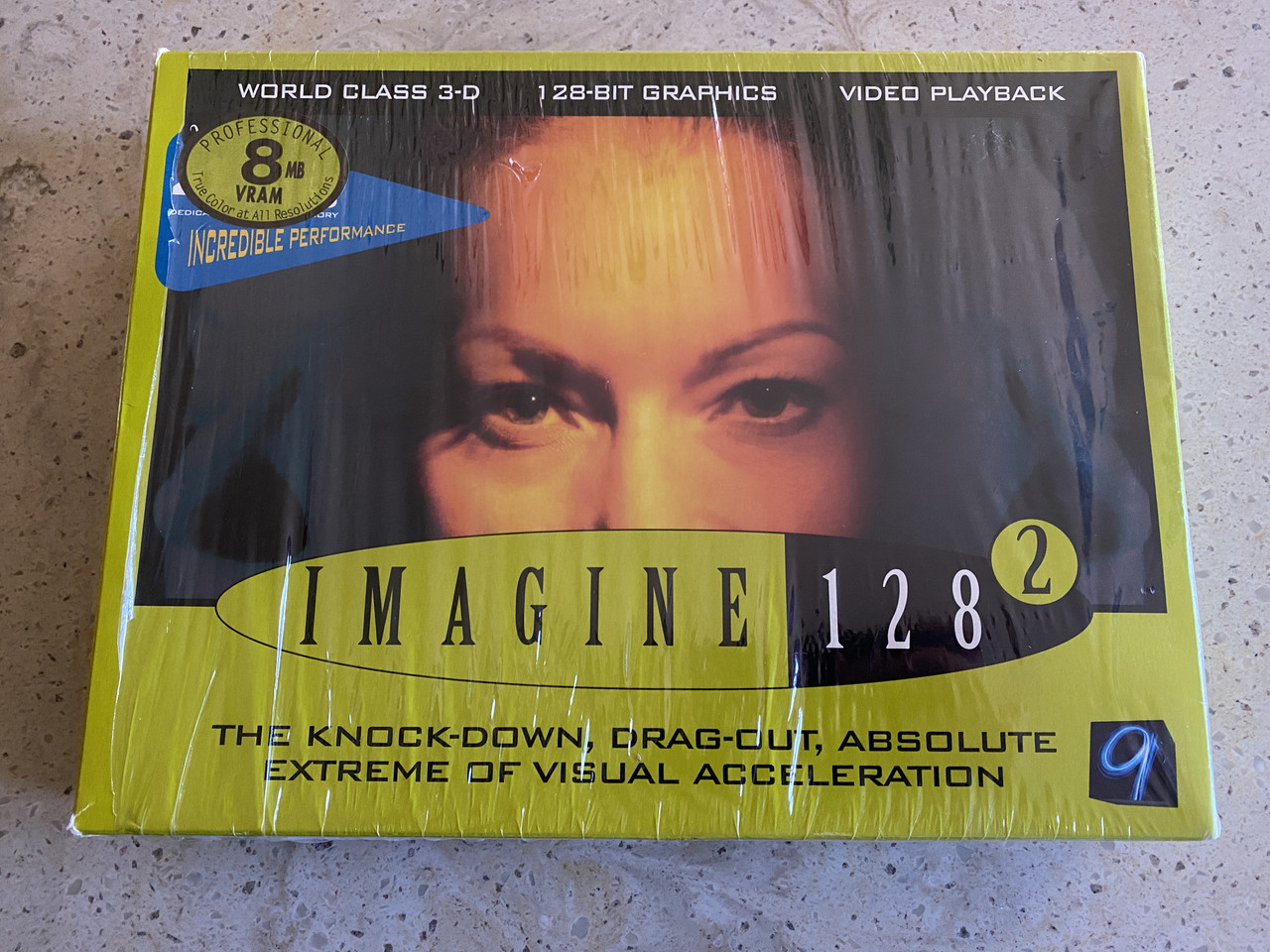 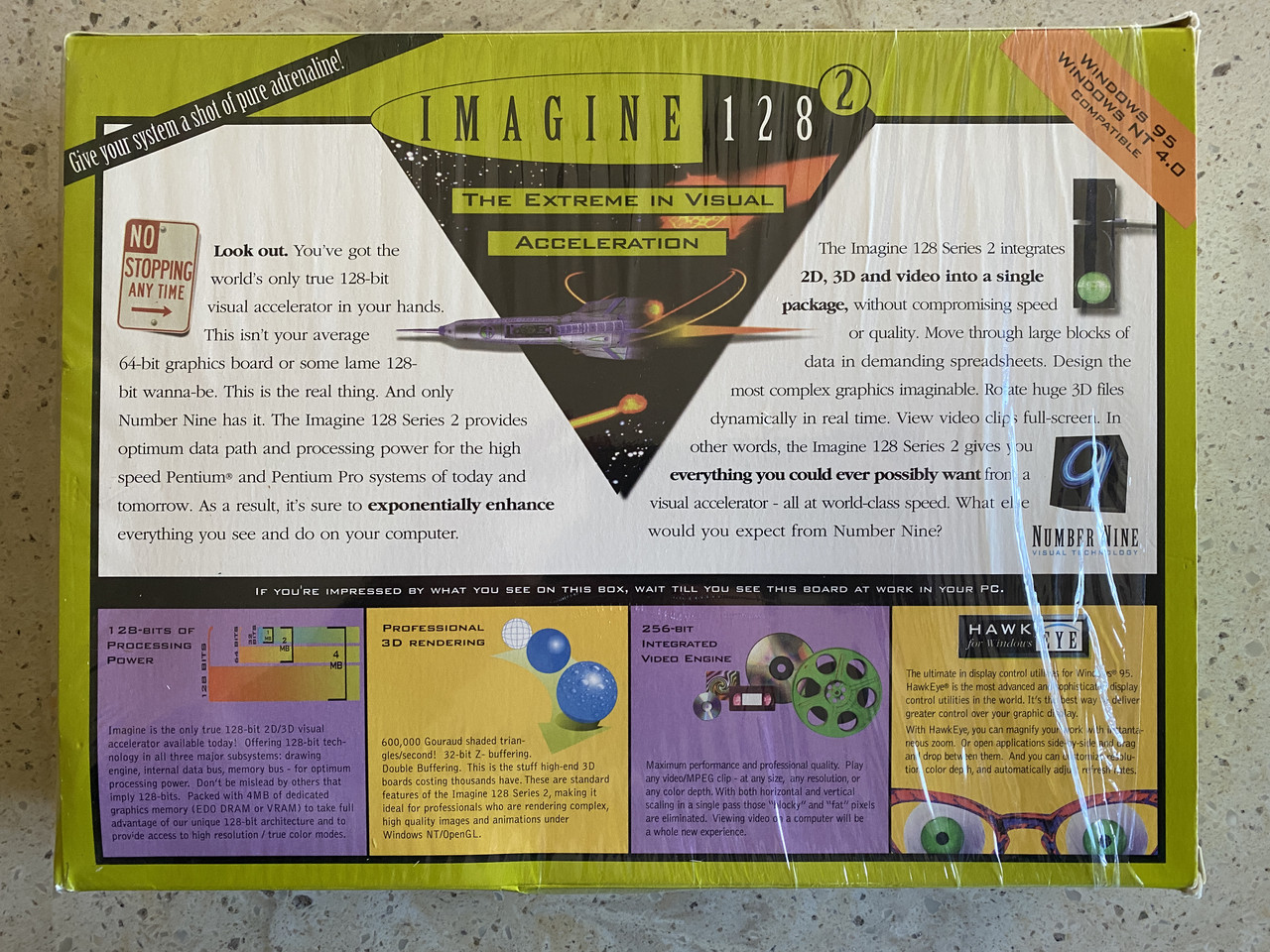 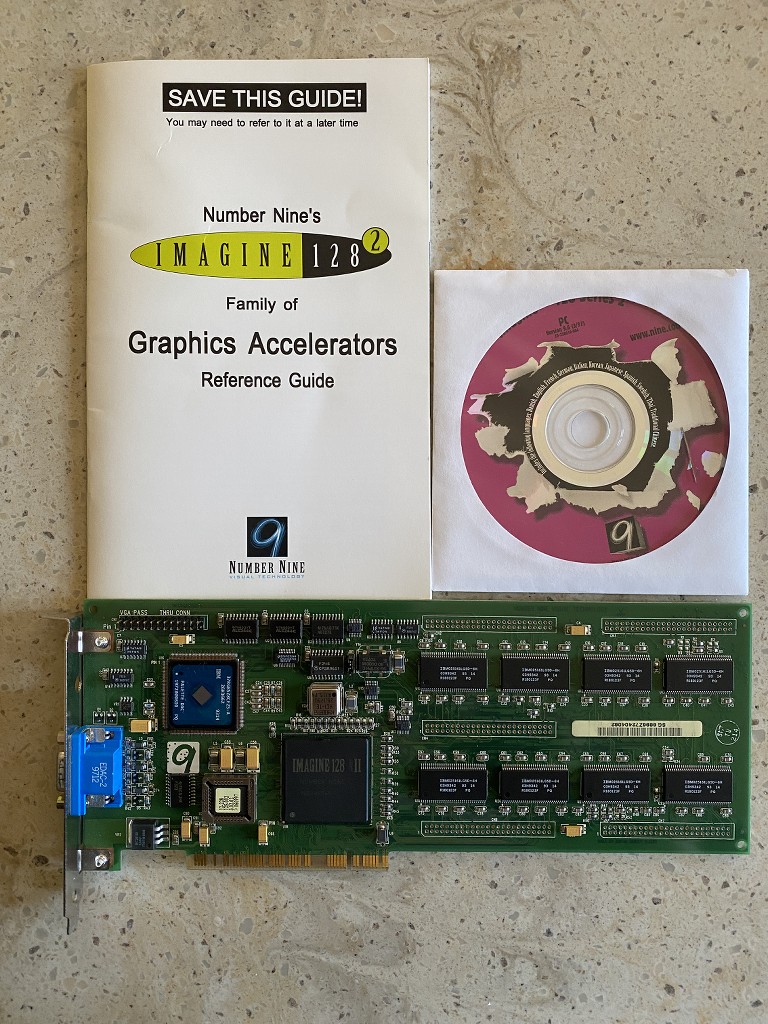 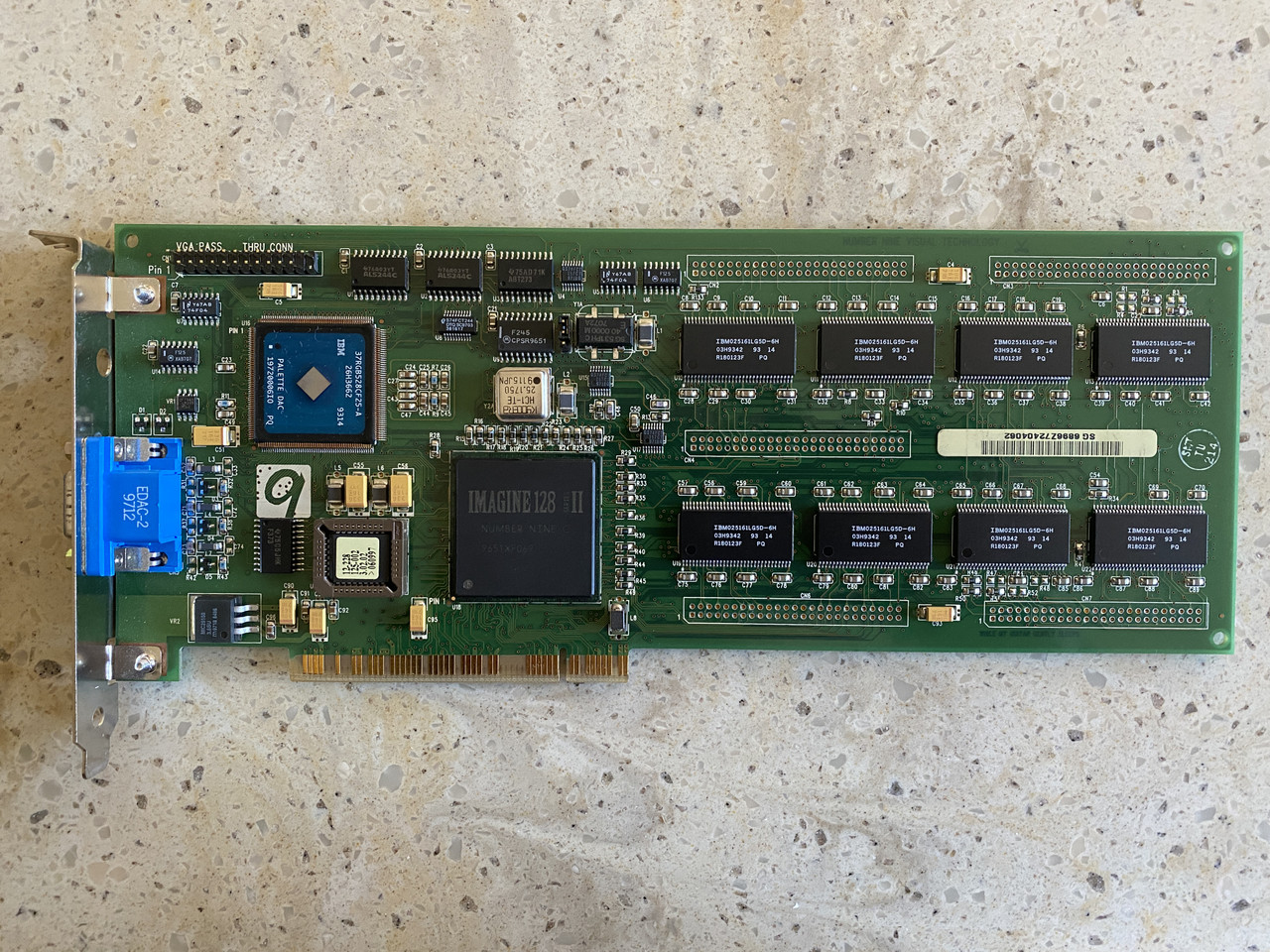
|
.jpg) Reality 332 Reality 332
   
Launched: 1996
Bus: PCI
Chipset: S3 ViRGE
RAMDAC:
RAMDAC Speed:
Memory: 2 MB EDO DRAM
Part #:
Price:
Known BIOS Versions: 2.18.08
The 9FX Reality 332 combined high-performance 64-bit 2D
graphics acceleration, advanced 3D-rendering capabilities and high-quality
video acceleration.
Advanced 3D Rendering Capabilities
The 9FX Reality 332's 3D-rendering capabilities include: hardware
texture mapping with perspective correction for improved image quality
and realism; bilinear filtering, which provides anti-aliasing to
eliminate the staircasing effect that is often seen at lower
resolutions; MIP Mapping, which eliminates the "blockiness" or
"jaggies"; 16-Bit Z-Buffering, which is the 3D-rendering technique that
manages the Z-data in hardware and off-loads the 3D processing from the
host processor; alpha-blending, which is used by games developers to
create transparent 3-dimensional objects; and fogging, which developers
use to create a hardware generated fog or haze.
High-Performance Graphics And Video Acceleration
In addition to delivering advanced 3D-rendering capabilities, Number
Nine's 9FX Reality 332 also provides conventional Windows and video
acceleration with a powerful 64-bit graphics engine. 2D and video
acceleration includes:
- high performance graphics acceleration capable of displaying
resolutions up to 1280 x 1024 at 256 colors at 85MHz (or
1024 x 768 at 65,000 colors, or 800 x 600 at 16.7 million
colors);
- integrated VGA core that enables use of VGA-dependent
applications and run DOS-based game at high-resolution,
with fluid-like motion;
- a Streams Processor that provides the stretching and YUV color
space conversion features required for full screen video playback
with both software CODECs and hardware MPEG-1 sources. The
streams processor also allows simultaneous display of graphics
and video of different color depths.
On 31st July 1996, Number Nine entered into an agreement with Dell Computer to offer their new 9FX Reality 332
graphics accelerator, based on S3's ViRGE chip, with Dell's Dimension XPS line of high-performance
computers, designed for performance-minded small and medium-sized
businesses, as well as the expanding home office market.
"As the entire industry scrambles to keep up with the demand for 3D
graphics, our partnership with Dell to bring affordable 3D functionality
to the mainstream PC market fills an important gap in the industry's
current product offering," said Larry McIntosh, Vice President, OEM Sales
of Number Nine. "In a highly competitive environment with a lot of
players jockeying for position, we believe that this OEM deal with Dell is
a strong endorsement of Number Nine's ability to deliver performance and
functionality at a great price. This agreement may represent one of the
highest unit opportunities in Number Nine's history."
The Reality 332 came in just 2 MB form, using the older and cheaper EDO DRAM.
More Images
.jpg) .jpg)
|
.png) 9FX Reality 772 9FX Reality 772
  
Launched: October 1996
Bus: PCI
Chipset: S3 ViRGE/VX
RAMDAC:
RAMDAC Speed:
Memory: 2 MB or 4 MB VRAM
Part #: 00-772001-005
Price: $199 street (2 MB), $279 street (4 MB)
Unveiled on 14th October 1996 and shipped in November, the 9FX Reality 772, its most powerful 64-bit 2D, 3D
and video accelerator designed to date. The 9FX Reality 772 was targeted at
power users who wanted lightning fast GUI acceleration, full featured
video acceleration, the latest in 3D games technology, and fast DOS
video performance, at a low price point. The PCI-based board was powered
by the new S3 ViRGE/VX graphics controller.
This processor combined a 64-bit 2D graphics engine, an advanced 3D rendering
engine and a Streams(TM) Processor that yielded superior, full-screen video and
MPEG playback.
The 9FX Reality 772 was equipped in either 2 MB or 4 MB high-speed, dual-ported VRAM configurations, with the 2 MB card having the option of a $99 2 MB VRAM expansion module (part #00-772002-001) to bring it up to 4 MB. This boosted the number of
available colors at higher resolutions and increased graphics performance in both 2D and
3D applications.
The 9FX Reality 772 supported Microsoft's DirectX APIs which
includes DirectDraw, Direct3D, and ActiveMovie. For video and/or MPEG Video-CD playback, the 9FX Reality 772 utilised on-board color interpolation and X/Y
video scaling for smooth, full screen video playback at up to 30 frames per
second.
Maximum colours/vertical refresh rate at each resolution:
| |
640x480 |
800x600 |
1024x768 |
1152x864 |
1280x1024 |
1600x1200 |
2048x864 |
| 2 MB VRAM |
16.8M |
16.8M |
65K |
65K |
256 |
256 |
256 |
| |
115 |
150 |
150 |
150 |
100 |
81 |
- |
| 4 MB VRAM |
16.8M |
16.8M |
16.8M |
16.8M |
16.8M |
65K |
65K |
| |
115 |
150 |
100 |
100 |
85 |
81 |
- |
The cards were bundled as standard with MPEG Arcade
Player from MediaMatics, Inc., Havoc (a very cool S3-ported ViRGE/VX-ready
game) from Reality Bytes, Inc., Total Access from Earthlink, and more.
More Images
.jpg) .jpg)
|
.jpg) Revolution 3D Revolution 3D

Launched: June 1997 (PCI version), August 1997 (AGP version)
Chipset: Number 9 T2R (Ticket to Ride) L2A0907
Bus: PCI or AGP
Memory: 4 MB or 8 MB WRAM, and later, 4 MB or 8 MB SGRAM.
RAMDAC: IBM RGB524
RAMDAC Speed: 220 MHz
Price: ?
Part #: 01-328002-004
Known BIOS Versions: 3.03.03
The Revolution 3D was the flagship product from Number Nine, winning many industry awards including being the "Editor's Choice Award Winner" by both PC Magazine and Byte Magazine. It was by far their most successful card in the company's 16-year history at launch. It originally came in either 4 MB or 8 MB WRAM versions, and was based on Number Nine's third-generation "Ticket to Ride" graphics accelerator chip featuring an uncompromised combination of 3D, Windows and MPEG performance capabilities. Supporting both Direct3D™ and OpenGL® 3D acceleration with a dedicated 128-bit 3D engine and a 650-MFLOPS (million floating point operations per second) 3D setup engine.
In November 1997, Number Nine announced a new version of the Revolution 3D with either 4 MB or 8 MB of SGRAM. Both these new versions would be available with PCI and AGP buses, and were targeted at users who did not need extreme high resolution true color requirements. "Memory is one of the most expensive components of a graphics accelerator," said Andrew Najda, chairman and founder of Number Nine Visual Technology. "SGRAM is not only an ideal memory for today's fast graphics accelerators, it's now considered a commodity component. With fast, lower cost memory, Number Nine's 128-bit "Ticket To Ride" processor and Microsoft Certified WHQL (Windows Hardware Quality Laboratories) stable drivers, the SGRAM version of the Revolution 3D will be able to hit new markets which have been out of the reach with previous generations of Number Nine technology due to their higher price points.". The SGRAM versions would be available in the first quarter of 1998, and both were estimated to cost below $200 at the time of the announcement.
At the same time (Nov 1997), Number Nine announced they were reducing the ESP (Estimated Street Price) cost of the existing Revolution 3D to $249 for the 4 MB WRAM version and $299 for the 8 MB WRAM version.
Both the 4 MB and 8 MB WRAM versions supported optional memory upgrade daughterboards that added 4 MB or 8 MB additional memory, for a total capacity of 16 MB.
Revolution 3D SGRAM graphics accelerator features:
- World's fastest 2D GUI (graphical user interface) drawing engine.
- A built-in 3D Floating Point Setup Engine which is tightly coupled to a 128-bit 3D Drawing Engine for superior 3D performance
- An 8KB on-chip texture cache for faster texture rendering.
- Atmospheric effects for Specular Lighting, Interpolated Fogging and Alpha Blending improve 3D image quality.
- 128-bit Video Engine allows smooth, full-screen, full-motion MPEG playback at up to 1152 x 870 at 16.8 million colors - without dropping video frames.
- A Front-end Color Space Converter de-compresses and converts MPEG color data from YUV to RGB which allows MPEG video clips to be scaled to full-screen resolutions - even when in true color display modes.
- Video scaling is processed as a texture by the 3D engine, scaled and color interpolated for full-motion playback without the blockiness normally associated with scaled video.
- A professional quality, externally mounted, 220 MHz. IBM DAC (digital to analog converter) provides a brighter, cleaner, crisper video signal to the monitor for a rock-solid image which is considered superior to products that incorporate integrated DAC within the processor.
- Designed to accelerate Windows® 95 with Direct3D™, Windows NT 3.51 and Windows NT® 4.0 with OpenGL™ 3D support.
The pic above shows the 4 MB PCI version. Factory 8 MB cards have the other 4 MB on the rear of the card.
The pics below show the 8 MB AGP variant (has the optional 4 MB WRAM memory upgrade installed from factory).
Images of this card are courtesy of Vogons member, Artex.
More Images
.jpg) .jpg) .jpg) .jpg) .jpg)
Artex's card above, and another Revolution 3D below:
.jpg) .jpg)
|
.png) Reality 334 Reality 334
  
Launched: October 1997
Bus: AGP or PCI
Chipset: S3 ViRGE/GX2
RAMDAC: (embedded in S3 chip)
RAMDAC Speed:
Memory: 4 MB SGRAM
Memory Speed: 100 MHz
Part #: 01-334003-000
Price: $129 Estimated Street Price
The Reality 334 was introduced on 30th October 1997. It was sold as a mid-range 2D/3D graphics and multimedia accelerator, targeted at PC users who want an all-in-one, all-purpose multimedia accelerator at an attractive price.
It was based on the S3 ViRGE/GX2 chipset which combine 64-bit 2D graphics acceleration for general business, financial and presentation applications with advanced 3D rendering capabilities for PC entertainment and full-screen playback of video clips.
The 3D rendering features included MIP mapping, trilinear filtering, and perspective correction of textures, to deliver images that are free of annoying visual artifacts such as "sparkle" and "jaggies." Other features include transparency for realistic rendering of glass, water and plastic objects; atmospheric effects such as fog and depth cueing to enable the rendering of real-world environments; and Z-buffering to speed the removal of hidden surfaces for improved performance and visual quality.
The Reality 334 also supported the S3 Scenic Highway LPB connection to provide an interface to MPEG-2 decoders for DVD upgrades.
| Maximum Colors at Various Resolutions w/ 4MB SGRAM |
| Maximum Vertical Refresh Rate (Hz) |
Max. Virtual |
| 640 x 480 |
800 x 600 |
1024 x 768 |
1152 x 864 |
1280 x 1024 |
1600 x 1200 |
2048 x 864 |
| 16.8M |
16.8M |
16.8M |
16.8M |
16.8M |
65K |
65K |
| 150 |
130 |
120 |
110 |
100 |
85 |
- |
|
.jpg) Revolution IV Revolution IV
  
Launched: June 1998
Chipset: Ticket to Ride IV
Bus: PCI
Memory: 16 MB or 32 MB SDRAM
RAMDAC: IBM
RAMDAC Speed: 250 MHz
Price: $169 MSRP (16 MB), $219 MSRP (32 MB)
Part #:
The Revolution IV with 16 MB of SDRAM was first announced on 16th June 1998, with the 32 MB variant on 24th August 1998. Both were based upon Number Nine's then-new fourth generation 128-bit graphics chip, Ticket to Ride IV - a single chip 3D/2D/MPEG coprocessor. It delivered an almost-threefold increase in performance over the prior generation Ticket to Ride processor which powered the Revolution 3D.
" Revolution IV with 16 or 32MB of video memory provides plenty of space to store and process massive textures, large images, and more, while maintaining flicker-free refresh rates at ultra-high resolutions. With rock solid display and driver quality and support for the stunning Silicon Graphics 1600SW digital flat panel monitor, Revolution IV will satisfy the most critical graphics professional, business user, and/or games enthusiast.
- Pure 128-Bit Graphics Power
- 16MB of SDRAM for Extreme performance
- World's First 128-bit Memory bus to SDRAM
- Integrated 250 MHz Pallette DAC
- Hot 3D, Awesome 2D Performance
- Full-Screen, 30 Frames/second MPEG-II Playback
- True Color (32-bit) to 1600 x 1200 @ 107Hz
- Extensive 3D Features for Direct3D(tm) and OpenGL(r) APIs
- $169 MSRP
- Ultimate Performance for Professional and Consumer Markets
Tomorrow’s visual technology today! Supercharge your system with 16MB of graphics acceleration for the cost of 8! Revolution IV is Number Nine's latest graphics accelerator, based on our fourth generation 128-bit chip, Ticket to Ride IV. For business, games, or media creation, Revolution IV offers the world's fastest combination of 2D and 3D performance. It is positioned to optimize the performance of Windows NT, Windows 98, and future operating systems."
Number Nine website, July 2017
A special version of the Revolution IV was released for Flat Panels, called Revolution IV-FP.
More Images
|
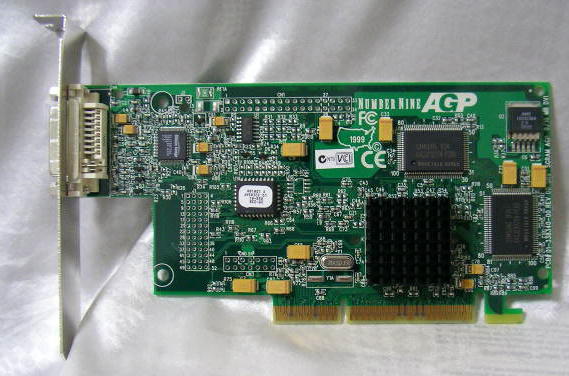 SR9 SR9
  
Launched: April 1999
Chipset: S3 Savage4 (86C395)
Bus: AGP 2x/4x
Memory: 8 MB, 16 MB or 32 MB SDRAM
Pixel Clock: 300 MHz
RAMDAC: (embedded in S3 chip)
Price: ?
Part #: 01-338120-00 (board rev.00, SVGA analog output), 01-338120-002 (board rev.02, SVGA analog output), 01-338340-00 (DVI output)
Known Board Revisions: 00, 02
Known BIOS Versions: 4.12.10, 4.1F.13b
 Number Nine's SR9 card was first announced on 28th April 1999 with shipments expected the following month. Number Nine's SR9 card was first announced on 28th April 1999 with shipments expected the following month.
The SR9 was based on the S3 Savage4 chipset, and came with either 8 MB, 16 MB or 32 MB of SDRAM video memory. Some SR9 cards came with a traditional 15-pin DSUB for SVGA video output; others got a DVI connector and an analog to digital converter chip near to it by Silicon Image - the latter required an upgrade module called the DFP Module.
The SR9 was the computer industry's first ever DVI (Digital Video Interface) graphics accelerator card. Number Nine showed a DVI-compliant SR9 under the auspices of the Digital Display Working Group (DDWG), a group headed by Intel, Compaq, Fujitsu, Hewlett Packard, IBM, NEC and Silicon Image. The DDWG was chartered with establishing the DVI specification, a single display interface standard that supports both conventional glass-tube monitors which use analog video signals, and the new breed of flat-panels displays that are fed a digitally pure video signal. The DVI specification also provides a clear roadmap to future high performance, high-resolution digital displays. The DDWG announced the DVI 1.0 specification in early April 1999.
It supported screen resolutions up to 1600 x 1200 in True Color (32-bit), up to 1920 x 1080 in Hi-Color (16-bit), and for flat panels up to 1280 x 1024 in 24-bit True Color.
The card is able to drive a monitor at 31.5 to 115 kHz horizontal refresh rate and from 60 to 150 Hz vertical refresh rate.
" The new SR9 Series 2D / 3D / DVD graphics accelerator delivers high-performance futuristic technology at affordable pricing with a rich feature set that enhances your entire gaming or desktop publishing experience! The SR9 is ready for the future with support for both 4X and 2X systems and Digital Flat Panel Monitors. Resolutions of up to 1600 x 1200 and incredible 3D textures of 2K x 2K combined with exclusive Texture Compression (S3TC) deliver images with smoothness and clarity like you’ve never seen before. Best of all, the SR9’s affordable pricing starts at a mere $79 (MSRP) making it one of the most inexpensive cards on the market.
Number Nine’s 128-bit SR9 accelerators are compatible with Intel’s announced and upcoming AGP 4X-based motherboards. Additionally, the SR9 will be available in 8-, 16- and 32-megabyte configurations, offering on-the-fly 3D-texture de-compression, 32-bit true-color 3D rendering and support for massive 3D textures as large as 2,048 x 2,048 pixels. These advanced features will allow users to view 3D graphics that are significantly more realistic and life-like. "
Hardware
- S3 Savage4 Processor
- Available in 8, 16 & 32MB memory configurations
- AGP 4X / 2X slot configuration available
- Supports standard CRT and Digital Flat Panel (DFP) monitors*
- High Quality DVD Playback with motion compensation
*With the purchase of a DFP add-on module.
3D Features
- Single-Pass multiple textures
- True-Color Rendering
- S3TC Texture Compression
- Single-Cycle Trilinear
- Bump Mapping
- Full Scene Anti-Aliasing
- Anisotropic Filtering
- Vertex Buffers
- 8-bit Stencil Buffer
- Triangle Setup Engine
- All DX6 Blending Modes
- Specular Lighting and Diffuse Shading
- W Buffer
- W Fog
- 32-bit Z-Buffering
- MPEG-2 Video Textures
- Sprite Anti-Aliasing
- Palletized Textures
- Perspective Correction
- Vertex and Table Fog
- Triangle Strips and Fans
- Reflection Mapping
- Texturing Morphing
- Shadows
- Procedural Textures
- Atmospheric Effects
2D Features
- Highly optimized 128-bit graphics engine
- Full featured 2D engine for acceleration of BitBLT, rectangle fill, linedraw, polygon fill, panning/scrolling and hardware cursor
- 8, 16, and 32 bpp mode acceleration
Software
- Comes with HawkEye IV custom display drivers and utilities
- Drivers support Windows 95, 98 and 2000, Direct 3D and OpenGL ICD
Number Nine website, early 2000
More Images
.jpg) .jpg)
.jpg) .jpg) .jpg) .jpg)
.jpg) .jpg) .jpg)
.jpg) .jpg) .jpg) .jpg)
|
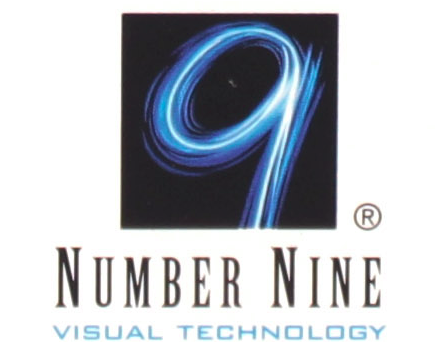 Number Nine / Number 9 / #9
Number Nine / Number 9 / #9
.jpg) Revolution 3D
Revolution 3D![]()
.png) Reality 334
Reality 334![]()
![]()
![]()
.jpg) Revolution IV
Revolution IV![]()
![]()
![]()
 SR9
SR9![]()
![]()
![]()
 Number Nine's SR9 card was first announced on 28th April 1999 with shipments expected the following month.
Number Nine's SR9 card was first announced on 28th April 1999 with shipments expected the following month.




 Number Nine unveiled the #9GXe in late 1992 with shipping in early 1993. Based on the 'then-new'
Number Nine unveiled the #9GXe in late 1992 with shipping in early 1993. Based on the 'then-new' 

.jpg)
.jpg)




.png)
.png)
.png)

.png)


.jpg)
.jpg)
.jpg)
.jpg)
.jpg)
.png)
.png)
.png)
.jpg)
.jpg)
.jpg)
.jpg)
.jpg)
.jpg)
.jpg)
.jpg)
.jpg)
.jpg)




.jpg)
.jpg)
.jpg)
.png)
.jpg)
.jpg)
.jpg)
.jpg)
.jpg)
.jpg)
.jpg)
.jpg)
.jpg)
.jpg)
.jpg)
.jpg)
.jpg)
.jpg)
.jpg)
.jpg)
.jpg)
.jpg)
.jpg)
.jpg)
.jpg)
.jpg)